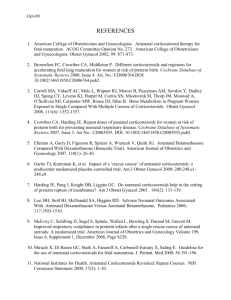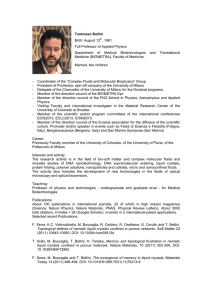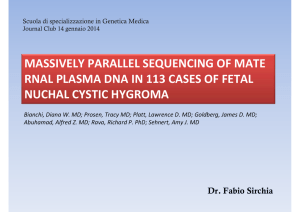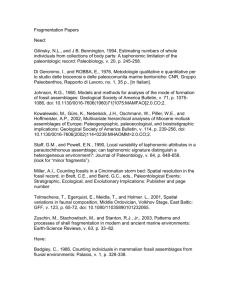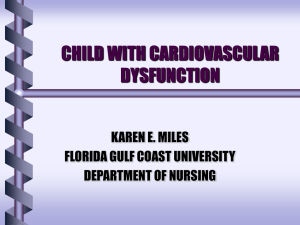Bibliography - Star Legacy Foundation
advertisement
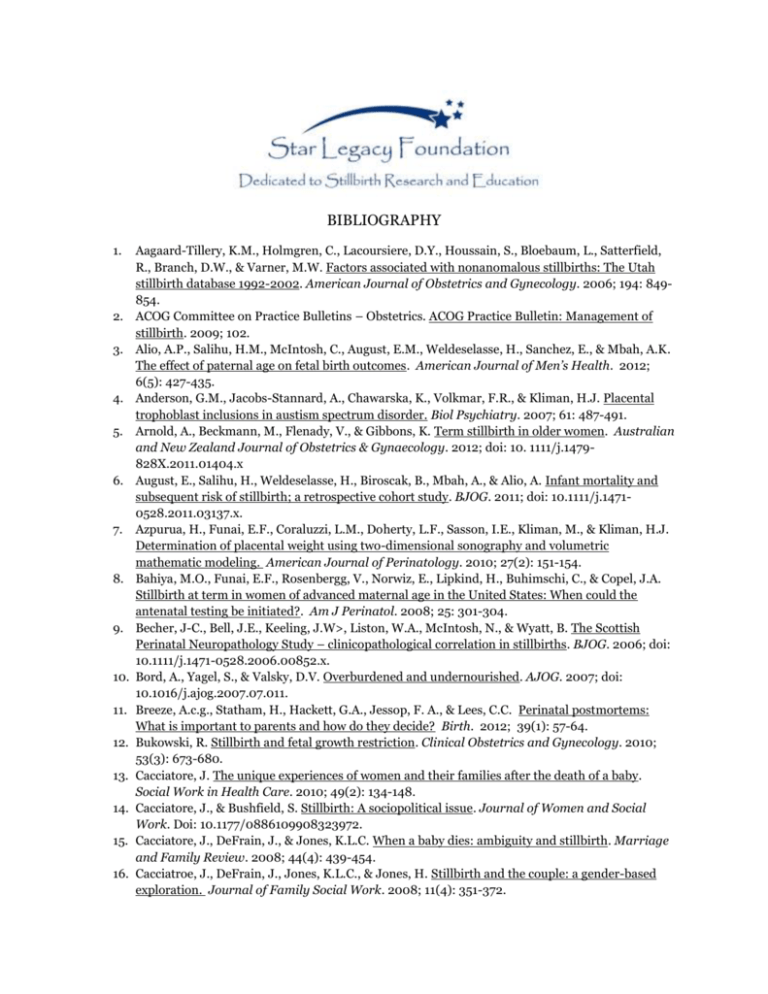
BIBLIOGRAPHY 1. 2. 3. 4. 5. 6. 7. 8. 9. 10. 11. 12. 13. 14. 15. 16. Aagaard-Tillery, K.M., Holmgren, C., Lacoursiere, D.Y., Houssain, S., Bloebaum, L., Satterfield, R., Branch, D.W., & Varner, M.W. Factors associated with nonanomalous stillbirths: The Utah stillbirth database 1992-2002. American Journal of Obstetrics and Gynecology. 2006; 194: 849854. ACOG Committee on Practice Bulletins – Obstetrics. ACOG Practice Bulletin: Management of stillbirth. 2009; 102. Alio, A.P., Salihu, H.M., McIntosh, C., August, E.M., Weldeselasse, H., Sanchez, E., & Mbah, A.K. The effect of paternal age on fetal birth outcomes. American Journal of Men’s Health. 2012; 6(5): 427-435. Anderson, G.M., Jacobs-Stannard, A., Chawarska, K., Volkmar, F.R., & Kliman, H.J. Placental trophoblast inclusions in austism spectrum disorder. Biol Psychiatry. 2007; 61: 487-491. Arnold, A., Beckmann, M., Flenady, V., & Gibbons, K. Term stillbirth in older women. Australian and New Zealand Journal of Obstetrics & Gynaecology. 2012; doi: 10. 1111/j.1479828X.2011.01404.x August, E., Salihu, H., Weldeselasse, H., Biroscak, B., Mbah, A., & Alio, A. Infant mortality and subsequent risk of stillbirth; a retrospective cohort study. BJOG. 2011; doi: 10.1111/j.14710528.2011.03137.x. Azpurua, H., Funai, E.F., Coraluzzi, L.M., Doherty, L.F., Sasson, I.E., Kliman, M., & Kliman, H.J. Determination of placental weight using two-dimensional sonography and volumetric mathematic modeling. American Journal of Perinatology. 2010; 27(2): 151-154. Bahiya, M.O., Funai, E.F., Rosenbergg, V., Norwiz, E., Lipkind, H., Buhimschi, C., & Copel, J.A. Stillbirth at term in women of advanced maternal age in the United States: When could the antenatal testing be initiated?. Am J Perinatol. 2008; 25: 301-304. Becher, J-C., Bell, J.E., Keeling, J.W>, Liston, W.A., McIntosh, N., & Wyatt, B. The Scottish Perinatal Neuropathology Study – clinicopathological correlation in stillbirths. BJOG. 2006; doi: 10.1111/j.1471-0528.2006.00852.x. Bord, A., Yagel, S., & Valsky, D.V. Overburdened and undernourished. AJOG. 2007; doi: 10.1016/j.ajog.2007.07.011. Breeze, A.c.g., Statham, H., Hackett, G.A., Jessop, F. A., & Lees, C.C. Perinatal postmortems: What is important to parents and how do they decide? Birth. 2012; 39(1): 57-64. Bukowski, R. Stillbirth and fetal growth restriction. Clinical Obstetrics and Gynecology. 2010; 53(3): 673-680. Cacciatore, J. The unique experiences of women and their families after the death of a baby. Social Work in Health Care. 2010; 49(2): 134-148. Cacciatore, J., & Bushfield, S. Stillbirth: A sociopolitical issue. Journal of Women and Social Work. Doi: 10.1177/0886109908323972. Cacciatore, J., DeFrain, J., & Jones, K.L.C. When a baby dies: ambiguity and stillbirth. Marriage and Family Review. 2008; 44(4): 439-454. Cacciatroe, J., DeFrain, J., Jones, K.L.C., & Jones, H. Stillbirth and the couple: a gender-based exploration. Journal of Family Social Work. 2008; 11(4): 351-372. 17. Carter, B.S. Neonatal and infant death: what bereaved parents can teach us. Journal of Perinatology. 2007; 27: 467-468. 18. Caughey, A.B., Musci, T.J. Complication of term pregnancies beyond 37 weeks of gestation. Obstet Gynecol. 2004; 103(1): 57-62. 19. Clark, S.L., Frye, D.R., Meyers, J.A., Belfort, M.A., Dildy, G.A., Kofford, S., Englebright, J., & Perlin, J.A. Reduction in elective delivery at <39 weeks of gestation: comparative effectiveness of 3 approaches to change and the impact on neonatal intensive care admission and stillbirth. Am J Obstet Gynecol. 2010; 203: 449.e1-6. 20. Cleary-Goldman, J., Malone, F.D., Vidaver, J., Ball, R.H., Nyberg, D.A., Comstock, C.H., Saade, G.R., Eddleman, K.A., Klugman, S., Dugoff, L., Timor-Tritsch, I.E., Craigo, S.D., Carr, S.R., Wolfe, H.M., Bianchi, D.W., & D’Alton, M. Impact of maternal age on obstetric outcome. Obstet Gynecol. 2005; 105 (5): 983-990. 21. Coletta, J., & Simpson, L.L. Maternal medical disease and stillbirth. Clinical Obstetrics and Gynecology. 2010; 53(3): 607-616. 22. Collins, J.H., & Collins, C.L. The human umbilical cord. The Placenta: Basic Science and Clinical Practice. Eds. J.C.P. Kingdom, E.R.M. Jauniaux, & P.M.S. O’Brien. RCOG Press. 23. Collins, J.H. , Collins, C.L., & Collins, C.C. Silent Risk: Issues about the human umbilical cord. Available online: http://www.preginst.com/silentrisk.pdf. 24. Collins, J.H., Collins, C.L., & Collins, C.C. Umbilical cord accidents 2010. Available online: http://www.preginst.com/UmbilicalCordAccidents2.pdf. 25. Dickinson, J.E. The continuing dilemma of stillbirth. Australian and New Zealand Journal of Obstetrics Y Gynaecology. 2011; 51: 1-2. 26. Downe, S., Kingdon, C., Kennedy, R., Norwell, H., McLaughlin, M., & Heazell, A.E.P. Postmortem examination after stillbirth: views of UK-based practitioners. European Journal of Obstetrics & Gynecology and Reproductive Biology. 2012; 162: 33-37. 27. Dudley, D.J., Goldenberg, R>, Conway, D., Silver, R., Saade, G.R., Varner, M.W., Pinar, H., Coustan, D., Bukowski, R., Stoll, B., Koch, M.A., Parker, C.B., & Reddy, U.M. A new system for determining the causes of stillbirth. Obstetrics & Gynecology. 2010; 116(2): 254-260. 28. Duke, C.W., Coea, A., Romiti, P.A, Martin, J, & Kirby, R.S. Challenges and priorities for surveillance of stillbirths: A report on two workshops. Public Health Reports. 2009. 124:652-659. 29. Efkarpidis, S., Alexopoulos, E., Kean, L., Liu, D., & Fay, T. Case-control study of factors associated with intrauterine fetal deaths. MedGenMed. 2004; 6(2): 53. 30. Erlandsson, K., Warland, J., Cacciatore, J., & Radestad, I. Seeing and holding a stillborn baby: Mothers’ feelings in relation to how their babies were presented to them after birth – Findings from an online questionnaire. Midwifery. 2012; doi: 10.1016/j.midw.2012.01.007. 31. Feldman, G.B. Prospective risk of stillbirth. Obstetrics & Gynecology. 1992; 79(4): 547 553. 32. Fell, D.B., Sprague, A.E., Liu, N., Yasseen, A.S., Wen, S., Smith, G., & Walker, M.C. H1N1 Influenza vaccination during pregnancy and fetal and neonatal outcomes. American Journal of Public Health. 2012; 102(6): e33-e40. 33. Flenady, V., Koopmans, L., Middleton, P., Froen, J.F., Smith, G.C., Gibbons, K., Coory, M., Gordon, A., Ellwood, D., McIntyre, H.D., Fretts, R., & Ezzati, M. Major risk factors for stillbirth in high-income countries: a systematic review and meta-analysis. Lancet. 2011; 377: 1331-1340. 34. Fretts, R.C. Etiology and prevention of stillbirth. American Journal of Obstetrics & Gynecology. 2005; 193: 1923-1935. 35. Fretts, R.C., & Duru, U.A. New Indications for Antepartum testing: Making the case for antepartum surveillance or timed delivery for women of advanced maternal age. Seminars in Perinatology. 2008; 32: 312-317. 36. Fretts, R.C., Elkin, E.B., Myers, E.R., & Heffner, L.J. Should older women have antepartum testing to prevent unexplained stillbirth? Obstet Gynecol. 2004; 104(1): 56-64. 37. Fretts, R.C., SChmittdiel, J., McLean, F.H., Usher, R.H., & Goldman, M.B. Increased maternal age and the risk of fetal death. New England Journal of Medicine. 1995; 333(15): 953-957. 38. Froen, J.F., Gardosi, J.O., Thurmann, A., Francis, A., & Stray-Pedersen, B. Restricted fetal growth in sudden intrauterine unexplained death. Acta Obstet Gynecol Scand. 2004; 83:801-807. 39. Froen, J.F., Heazell, A.E.P., Tveit, J.V.H., Saastad, E., Fretts, R.C., & Flenady, V. Fetal movement assessment. Semin Perinatol. 2008; 32: 243-246. 40. Froen, J.F., Tvelt, J.V.H., Saastad, E., Bordahl, P.E., Stray-Pedersen, B., Heazell, A.E.P., Flenady, V., & Fretts, R.C. Management of decreased fetal movements. Seminars in Perinatology. 2008; 32: 307-311. 41. Fung, AM, Wilson, DL, Barnes, M., and Walker, SP. Obstructive sleep apnea and pregnancy: the effect on perinatal outcomes. Journal of Perinatology. 2012; 32: 399 – 406. 42. Gold, K.J. Navigating care after a baby dies: a systematic review of parents experiences with health providers. Journal of Perinatology. 2007; 27: 230-237. 43. Gold, K.J., Kuznia, A.L., & Hayward, R.A. How physicians cope with stillbirth or neonatal death. Obstet Gynecol. 2008; 112(1): 29-34. 44. Gold, K.J., Sen, A., & Hayward, R.A. Marriage and cohabitation outcomes after pregnancy loss. Pediatrics. 2010; online: http://pediatrics.aappublications.org/content/125/5/e1202.full.html. 45. Gordon, A., Raynes-Greenow, C., McGeechan, K., Morris, J., & Jeffery, H. Stillbirth risk in a second pregnancy. Obstetrics & Gynecology. 2012; 119(3): 509-517. 46. Haavaldsen, C., Sarfraz, A., Samuelsen, S.O., & Eskild, A. The impact of maternal age on fetal death: does length of gestation matter? Am J Obstet Gynecol. 2010; 203: 554.e1-8. 47. Hannah, ME., Hannah, W.J., Hellmann, J., Hewson, S., Milner, R., Willan, A., and the Canadian Multicenter Post-term pregnancy trial group. Induction of labor as compared with serial antenatal monitoring in post-term pregnancy. New England Journal of Medicine. 1992; 326(24): 1587-1592. 48. Harger, J.H., Archer, D.F., Marchese, S.G., Muracca-Clemens, M., & Garver, K.L. Etiology of recurrent pregnancy losses and outcome of subsequent pregnancies. Obstetrics & Gynecology. 1983; 62(5):574-581. 49. Hawegawa, J., Farina, A., Nakamura, M., Matsuoka, R>, Ichizuka, K., Sekizawa, A., & Okai, T. Analysis of the ultrasonographic findings predictive of vasa previa. Prenat Diagn. 2010; 30:11211125. 50. Hasegawa, J., Farina, A., Simonazzi, G., Bisulli, M., Puccetti, C., Pilu, G., Gabrielli, S., & Rizzo, N. Umbilical cord insertion into the lower segment of the uterus at 11 to 13 weeks’ gestation is associated with maternal serum PAPP-A. Prenat Diagn. 2011. Doi: 10.1002/pd.2708. 51. Hasegawa, J., Iwasaki, S., Matsuoka, R., Ichizuka, K., Sekizawa, A., & Okai, T. Velamentous cord insertion caused by oblique implantation after invitro fertilization and embryo transfer. J. Obstet. Gynaecol. Res. 2011; doi: 10.1111/j.1447-0756.2011.01555.x. 52. Hasegawa, J., Matsuoka, R., Ichizuka, K., Sekizawa, A., & Okai, T. Ultrasound diagnosis and management of umbilical cord abnormalities. Obstet Gynecol. 2009; 48(1): 23-27. 53. Hasegawa, J., Mimura, T., Morimoto, T., Matsuoka, R., Ichizuka, K., Sekizawa, A., & Okai, T. Detection of umbilical venous constriction by Doppler flow measurement at midgestation. Ultrasound Obstet Gynecol. 2010; 36:196-201. 54. Hayes, E.K., Lechowicz, A., Petrik, J.J., Storozhuk, Y., Paez-Parent, S., Dai, Q., Samjoo, I.A., Mansell, M., Gruslin, A., Holloway, A.C., & Raha, S. Adverse fetal and neonatal outcomes associated with a life-long high fat diet: Role of altered development of the placental vasculature. 2012. PLoS ONE 7(3): e33370. Doi: 10.1371/journal.pone.0033370. 55. Heazell, A.E. Towards and end to stillbirth. BMJ. 2010; 341:c5070. 56. Heazell, A., McLaughlin, M., Schmidt, E., Cox, P., Flenady, V., Khong, T., Downe, S. A difficult conversation? The views and experiences of parents and professionals on the consent process for perinatal postmortem after stillbirth. BJOG 2012. 119: 987-997. 57. Hochberg, T. The art of medicine: moments held – photographing perinatal loss. The Lancet. 2011; 377: 1310-1311. 58. Hodgson, E., & Norwitz, E. Does low blood pressure increase the risk of stillbirth? Contemporary OB/GYN. 2006; Oct 55-58. 59. Juang, L., Sauve, R., Birkett, N., Fergusson, D., & van Walraven, C. Maternal age and risk of stillbirth: a systematic review. Canadian Medical Association Journal. 2008; 178(2): 165-172. 60. Jacobsson, B., Ladfors, L., & Milsom, I. Advanced maternal age and adverse perinatal outcome. Obstet Gynecol. 2004; 104(4): 727-733. 61. Johnson, J. & Tough, S. Delayed Child-Bearing. J Obstet Gynaecol Can. 2012; 34(1): 80-93. 62. Kliman, H.J. Behind every healthy baby is a healthy placenta. Online: http://info.med.yale.edu/obgyn/kliman/placenta/behind.html. 63. Kliman, H.J., The placenta revealed. American Journal of Pathology. 1993; 143(2): 332-336. 64. Kliman, H.J. The umbilical cord. Yale University School of Medicine. Online: http://www.med.yale.edu/obgyn/kliman/placenta/articles/EOR_UC/Umbilical_Cord.html. 65. Kliman, H.J., Perrotta, P.L., & Jones, D.C. Transactions of the fifteenth annual meeting of the society of perinatal obstetricians. American Journalof Obstetrics & Gynecology. 1995; 173(4). 66. Timmer, A., van der Meer, J., Ravise, J.M., Veeger, N.J.G.M., & Holm, J.P. Evaluation of 1025 fetal deaths: proposed diagnostic workup. Am J Obstet Gynecol 2012; 206:53.e1-12. 67. Krakowiak, P., Walke, C.K., Bremer, A.A., Baker, A.S., Ozonoff, S., Hansen, R.L., & HertzPicciotto, I. Maternal metabolic conditions and risk for autism and other neurodevelopmental disorders. Pediatrics. 2012; 129(5): 1-8. Doi: 10.1542/peds.2011-2583. 68. Liston, R.M., Bloom, K., & Zimmer, P. The psychological effects of counting fetal movements. BIRTH 1994; 21 (3): 135-140. 69. Makelarski, J.A., Romitti, P.A., Caspers, K.M., Puzhankara, S., McDowell, B.D., & Piper, K.N. Use of active surveillance methodologies to examine over-reporting of stillbirths on fetal death certificates. Birth Defects Research (Part A) 2011; 91:1004-1010. 70. Marroun, H.E., Zeegers, M., Steegers, E.A.P., van der Ende, J., Schenk, J.J., Hofman, A., Jaddoe, V.W.V., Verhulst, F.C., & Tiemeier, H. International Journal of Epidemiology. 2012; doi: 10.1093/ije/dys043. 71. McGregor, J.A. Group B Strep: A patient/provider approach for optimizing care. OBGYN.net. 2011; available online: http://www.obgyn.net/women/women.asp. 72. McKenna, D., & Dornan, J. Who’s looking for the high-risk fetus in the low-risk mother? The Obstetrician & Gynaecologist. 2005; 7:50-51. 73. McKenna, D., Tharmaratnam, S., Mahsud, S., Bailie, C., Harper, A., & Dornan, J. A randomized trial using ultrasound to identify the high-risk fetus in a low-risk population. Obstet Gynecol. 2003; 101(4): 626-632. 74. Miller, D.A. Is advanced maternal age an independent risk factor for uteroplacental insufficiency? American Journal of Obstetrics and Gynecology. 2005; 192: 1974-1982. 75. Nakamura, E., Okamoto, T., Nagaya, K., & Hayashi, T. Maternal deletion allele of angiotensinconverting enzyme gene is associated with fetal growth restriction. Pediatric and Developmental Pathology. 2012; 15: 114-117. 76. O’Leary, J., Warland, J., & Parker, L. Bereaved parents’ perception of the grandparents’ reactions to perinatal loss and the pregnancy that follows. Journal of Family Nursing. 2011; 17(3): 330356. 77. Paneth, N. Stillbirth: Still important and still a puzzle. Epidemiology. 2012; 23(2): 255-256. 78. Parast, M.M., Crum, C.P., & Boyd, T.K. Placental histologic criteria for umbilical blood flow restriction in unexplained stillbirth. Human Pathology. 2008; 39: 948-953. 79. Pasupathy, D., & Smith, G.C.S. The analysis of factors predicting antepartum stillbirth. Minerva Ginecologica. 2005; 57: 397-410. 80. Patrelli, T.S., Addetta, F.D., Gizzo, S., Franchi, L., Di Gangi, S., Sianesi, N., Peri, F., Pedrazzi, G., Berretta, R., Piantelli, G., Lukanovic, A., Nardellia, G.B., & Modena, A.B. Correlation between fetal movement revealed in actography and fetal-neonatal well-being: observational study on 3805 pregnancies followed in a Northern Italy tertiary care hospital. Clin Exp Obst & Gyn. 2011: 38(4): 382-385. 81. Pinar, H., & Carpenter, M. Placenta and umbilical cord abnormalities seen with stillbirth. Clinical Obstetrics and Gynecology. 2010; 53(3): 656-672. 82. Prout, A.P., Frasch, M., Veldhuizen, R.A.W., Hammond, R., Ross, M.G., & Richardson, B.S. Systemic and cerebral inflammatory response to umbilical cord occlusions with worsening acidosis in the ovine fetus. Am J Obstet Gynecol. 2010; 202:82.e1-9. 83. Ray, J.G. and Urquia, M.L. Risk of stillbirth at extremes of birth weight between 20 to 41 weeks gestation. Journal of Perinatology. 2012; doi: 10.1038/jp.2012.60. 84. Reddy, U.M. Management of pregnancy after stillbirth. Clinical Obstetrics and Gynecology. 2010; 53(3): 700-709. 85. Reddy, U.M. Prediction and prevention of recurrent stillbirth. Obstetrics & Gynecology. 2007; 110(5): 1151-1164. 86. Reddy, U.M., Ko, C-W., & Willinger, M. Maternal age and the risk of stillbirth throughout pregnancy in the United States. American Journal of Obstetrics & Gynecology. 2006; 195: 764770. 87. Resnik, R. Intrauterine growth restriction. Obstetrics & Gynecology. 2002; 99(3): 490-496. 88. Rotmensch, S., Liberati, M., Luo, J.S., Kliman, H.J., Gollin, Y., Bellati, U., Hobbins, J.C., & Copel, J.A. Color Doppler flow patterns and flow velocity waveforms of the intraplacental fetal circulation in growth-retarded fetuses. Am J Obstet Gynecol. 1994; 171 (5): 1257-1264. 89. Royal College of Obstetricians and Gynaecologists. Green-top Guideline 57: Reduced fetal movements. 2011. 90. Saade, G. Risk of stillbirth according to second trimester aneuploidy screen result in the Stillbirth Collaborative Research Network; a population-based study. Am J Obstet Gynecol. 2011; Abstract 62. 91. Saleemuddin, A., Tantbirojn, P., Sirois, K., Crum, C.P., Boyd, T.K., Tworoger, S., & Parast, M.M. Obstetric and perinatal complications in placentas with fetal thrombotic vasculopathy. Pediatric and Developmental Pathology. 2010; 13: 459-464. 92. Salihu, H.M., Sharma, P.P., Aliyu, M.H., Kristensen, S., Grimes-Dennis, J., Kirby, R.S., & Smulian, J. Is small for gestational age a marker of future fetal survival in utero? Obstetrics & Gynecology. 2006; 107(4): 851-856. 93. Seaton, S.E., Field, D.J., Draper, E.S., Manktelow, B.N., Smith, G.C.S, Springett, A., & Smith, L.K.. Socioeconomic inequalities in the rate of stillbirths by cause: a population-based study. BMJ Open; 2012. Doi:10.1136/bmjopen-2012-001100. 94. Sharkey, J.T., Cable, C., & Olcese, J. Melatonin sensitizes human myometrial cells to oxytocin in a protein kinase cα/extracellular-signal regulated kinase-dependent manner. J Clin Endocrinol Metab. 2010; 95(6): 2902-2908. 95. Sharma, P.P., Salihu, H.M., Oyelese, Y., Ananth, C.V., & Kirby, R.S. Is race a determinant of stillbirth recurrence? Obstetrics & Gynecology. 2006; 107(2); 391-397. 96. Shinde, K.K., Bangal, V.B., Kwatra, A., & Borawake, S.K. Lessons learnt from umbilical cord accidents: are these stillbirths preventable? Int J Stud Res. 2012; 2(1): 14-17. 97. Silver, R.M. Optimal “work-up” of stillbirth: evidence! Am J Obstet Gynecol. 2012; doi: 10.1016/j.ajog.2011.10.025. 98. Silver, R. Stillbirth collaborative research network: proximate causes of death in a prospective, population based, multi-center, case-control study with a standardized protocol. AJOG.org. 2009. Doi: 10.1016/j.ajog.2009.10.020. 99. Silver, R. Varner, M.W., Reddy, U., Goldenberg, R., Pinar, H., Conway, D., Bukowski, R., Carpenter, M., Hogue, C., Willinger, M., Dudley, D., Saade, G., & Stoll, B. Work-up of stillbirth: a review of the evidence. AJOG. 2007. Doi: 10-.1016/j.ajog.2006.11.041. 100. Smith, G.C.S. First-trimester determination of complications of late pregnancy. JAMA. 2010; 303(6): 561-562. 101. Smith, G. C., Predicting antepartum stillbirth. Clinical Obstetrics and Gynecology. 2010; 53(3): 597-606. 102. Smith, G.C.S., & Fretts, R.C. Stillbirth. The Lancet. 2007; 370: 1715-1725. 103. Smith, G.C.S., Pell, J.P., & Dobbie, R. Caesarean section and risk of unexplained stillbirth in subsequent pregnancy. The Lancet. 2003. 362: 1779-1784. 104. Smith, G.C.S., Shah, I., White, I.R., Pell, J.P., & Dobbie, R. Previous preeclampsia, preterm delivery, and delivery of a small for gestational age infant and the risk of unexplained stillbirth in the second pregnancy: a retrospective cohort study, Scotland, 1992-2001. Am J Epidemiol. 2007; 165: 194-202. 105. Smith, G.C.S., Wood, A.M., Pell, J.P., White, I.R., Crossley, J.A., & Dobbie, R. Secondtrimester maternal serum levels of alpha-fetoprotein and the subsequent risk of Sudden Infant Death Syndrome. New England Journal of Medicine. 2012; 351(10): 978-986. 106. Spong, C.Y. Add stillbirth to the list of outcomes to worry about in a pregnant woman with a history of preterm birth or fetal growth restriction. Obstet & Gynecol. 2012; 119(3): 495497. 107. Spong, C.Y., ed. Stillbirth: Prediction, Prevention, and Management. 2011. WileyBlackwell; New Jersey. 108. St John, A, Cooke, M, & Goopy, S. Shrouds of Silence: Three women’s stories of prenatal loss. Australian Journal of Advanced Nursing. 109. Stacey, T., Thompson, J.M.D., Mitchell, E.A., Ekeroma, A.J., Zuccollo, J.M., & McCowan, L.M.E. Association between maternal sleep practices and risk of late stillbirth: a case-control study. BMJ. 2011; 342: d3403. 110. Stacey, T., Thompson, J.M.D., Mitchell, E.A., Ekeroma, A., Zuccollo, J., & McCowan, L.M.E. Maternal perception of fetal activity and late stillbirth risk: Findings from the Auckland Stillbirth Study. Birth. 2011; 38(4): 1-6. 111. Stacey, T., Thompson, J.M.D., Mitchell, E.A., Ekeroma, A.J., Zuccollo, J.M., & McCowan, L.M.E. Relationship between obesity, ethnicity, and risk of late stillbirth; a case control study. BMC Pregnancy Childbirth. 2011; published online. Doi: 10.1186/1471-2393-11-3. 112. Stanton, C., Lawn, J.E., Rahman, H., Wilczynska-Ketende, K., & Hill, K. Stillbirth rates: delivering estimates in 190 countries. Lancet. 2011; 367: 1487-1494. 113. Stillbirth Collaborative Research Network Writing Group. Association between stillbirth and risk factors known at pregnancy confirmation. JAMA. 2011; 306(2): 2469-2479. 114. Stillbirth Collaborative Research Network Writing Group. Causes of death among stillbirths. JAMA. 2011; 306(22): 2459-2468. 115. Stock, S.J., Ferguson, E., Duffy, A., Ford, I., & Norman, J.E. Outcomes of elective induction of labour compared with expectant management: population based study. BMJ. 2012; doi: 10.1136/bmj.e2838. 116. Stone, J. Advanced maternal age and the risk of antepartum stillbirth. Modern Medicine. 2012. Online: http://license.icopyright.net/3.7503?icx_id=769663. 117. Stotland, NE and Caughey, A.B. What should patients be told about obesity-related risks? Journal of Perinatology. 2012; 30: 439-440. 118. Surkan, P.J., Stephansson, O., Dickman., & Cnattingius, S. Previous preterm and small-forgestational age births and the subsequent risk of stillbirth. N Engl J Med. 2004: 350(8): 777-785. 119. Tantbirojn, P., Saleemuddin, A., Sirois, K., Crum, C.P., Boyd, T.K., Tworoger, S. & Parast, M.M. Gross abnormalities of the umbilical cord: Related placental histology and clinical significance. Placenta. 2009; 30: 1083-1088. 120. Thomsen, A.C., Moup, L., & Hansen, K.B. Antibiotic elimination of group-B streptococci in urine in prevention of preterm labour. Lancet. 1987; 14.1(8533): 591-593. 121. Towers, C.V., Juratsch, C.E., & Garite, T.J. The fetal heart monitor tracing in pregnancies complicated by a spontaneous umbilical cod hematoma. Journal of Perinatology. 2009; 29: 517520. 122. Van Dinter, M.C., Graves, L. Managing Adverse Birth Outcomes: Helping Parents and Families Cope. Am Fam Physician. 2012; 85(9): 900-904. 123. Walker, K., Bugg, G.J., Macpherson, M., & Thornton, J. Induction of labour at term for women over 35 years old: a survey of the views of women and obstetricians. Eur J Obstet Gynecol.2012; doi: 10.1016/j.ejogrb.2012.02.016. 124. Warland, J. Pregnancy women who experienced late stillbirth appear less likely to have slept on their left. Evidence-Based Nursing. 2011. Doi: 10.1136/ebn.2011.100175. 125.Warland, J. & McCutcheon, H.. Is there an association between maternal hypotension and poor pregnancy outcome? A review of contemporary literature. Australian College of Midwives Incorporated. 2002; 15(4): 22-26. 126. Warland, J. & McCutcheon, H. The ‘quit’ smoker and stillbirth risk: A review of contemporary literature in the light of findings from a case-control study. Midwifery. 2011; 27:607-611. 127. Warland, J., McCutcheon, H., & Baghurst, P. Maternal blood pressure in pregnancy and stillbirth: a case-control study of third-trimester stillbirth. Am J Perinatol. 2008; 25:311-317. 128. Warland, J., McCutcheon, H., & Baghurst, P. Placental position and late stillbirth: a casecontrol study. Journal of Clinical Nursing. 2009; 18: 1602-1606. 129. Warrander, L.K., Batra, G., Bernatavicius, G., Greenwood, S.L., Dutton, P., Jones, R.L., Sibley, C.P., and Heazell, A.E.P. Maternal perception of reduced fetal movements in associated with altered placental structure and function. PLoS One. 2012; 7(4): e34851. 130. Weeks, J.W. Antepartum testing for women with previous stillbirth. Seminars in Perinatology. 2008; 32:301-306. 131. Werner, E.F., & Lockwood, C.J. Thrombophilias and stillbirth. Clinical Obstetrics and Gynecology. 2010; 53(3): 617-627. 132. Wilson,B. Sonography of the placenta and umbilical cord. Radiologic Technology. 2008; 79(4): 333S-345S. 133. Winje, B.A., Roald, B., Kristensen, N.P., & Froen, J.F. Placental pathology in pregnancies with maternally perceived decreased fetal movement – a population-based nested case-cohort study. PLoS One. 2012; 7(6): e39259. 134. Wisborg, K., Ingerslev, H.J., & Henriksen, T.B. IVF and stillbirth: a prospective follow-up study. Human Reproduction. 2010. 25 (5); 1312-1316. 135.Yeong, C.T., Tan, K.H., Tee, C.S., & Yeo, G.S.H. Optimising management of stillbirths in modern Singapore. Singapore Med J. 1997; 38(8); 317-320. 136. Zerbo, O., Iosif, A.M., Walker, C., Ozonoff, S., Hansen, R.L., & Hertz-Picciotto, I. Is maternal influenza or fever during pregnancy associated with autism or developmental delays? Results from the CHARGE (Childhood Autism Risks from Genetics and Environment) Study. J Autism Dev Disord. 2012; doi 10.1007/s10803-012-1540.x 137.
